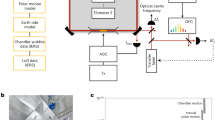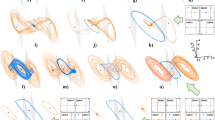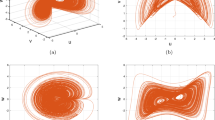Abstract
Saturn's satellite Hyperion has been predicted to be in a chaotic rotation state as a result of its irregular shape and tidal interactions1. However, an analysis of Voyager 2 images by Thomas et al.2 contradicted this prediction. These authors analysed 14 images obtained over 61 days and interpreted them to be consistent with a coherent (non-chaotic) rotation period of 13.1 days. The interpretation of the Voyager data has, however, been criticized by Peale and Wisdom3, who argued that the low sampling frequency does not allow chaotic or non-chaotic rotation to be distinguished. We report here new observations which were obtained with a higher sampling frequency. These data conclusively show that the 13.1-day period found by Thomas et al. was not due to coherent rotation.
This is a preview of subscription content, access via your institution
Access options
Subscribe to this journal
Receive 51 print issues and online access
$199.00 per year
only $3.90 per issue
Buy this article
- Purchase on SpringerLink
- Instant access to full article PDF
Prices may be subject to local taxes which are calculated during checkout
Similar content being viewed by others
References
Wisdom, J., Peale, S. & Mignard, F. Icarus 58, 137–152 (1984).
Thomas, P., Veverka, J., Wenkert, D., Danielson, G. E. & Davies, M. E. Nature 307, 716–717 (1984).
Peale, S. & Wisdom, J. Am. astr. Soc. 16, 686 (1984).
Landolt, A. U. Astr. J. 78, 959–981 (1973).
Author information
Authors and Affiliations
Rights and permissions
About this article
Cite this article
Binzel, R., Green, J. & Opal, C. Chaotic rotation of Hyperion?. Nature 320, 511 (1986). https://doi.org/10.1038/320511a0
Received:
Accepted:
Issue date:
DOI: https://doi.org/10.1038/320511a0
This article is cited by
-
Control of dumbbell satellite orbits using moving mass actuators
Nonlinear Dynamics (2022)
-
Hyperion's sponge-like appearance
Nature (2007)



